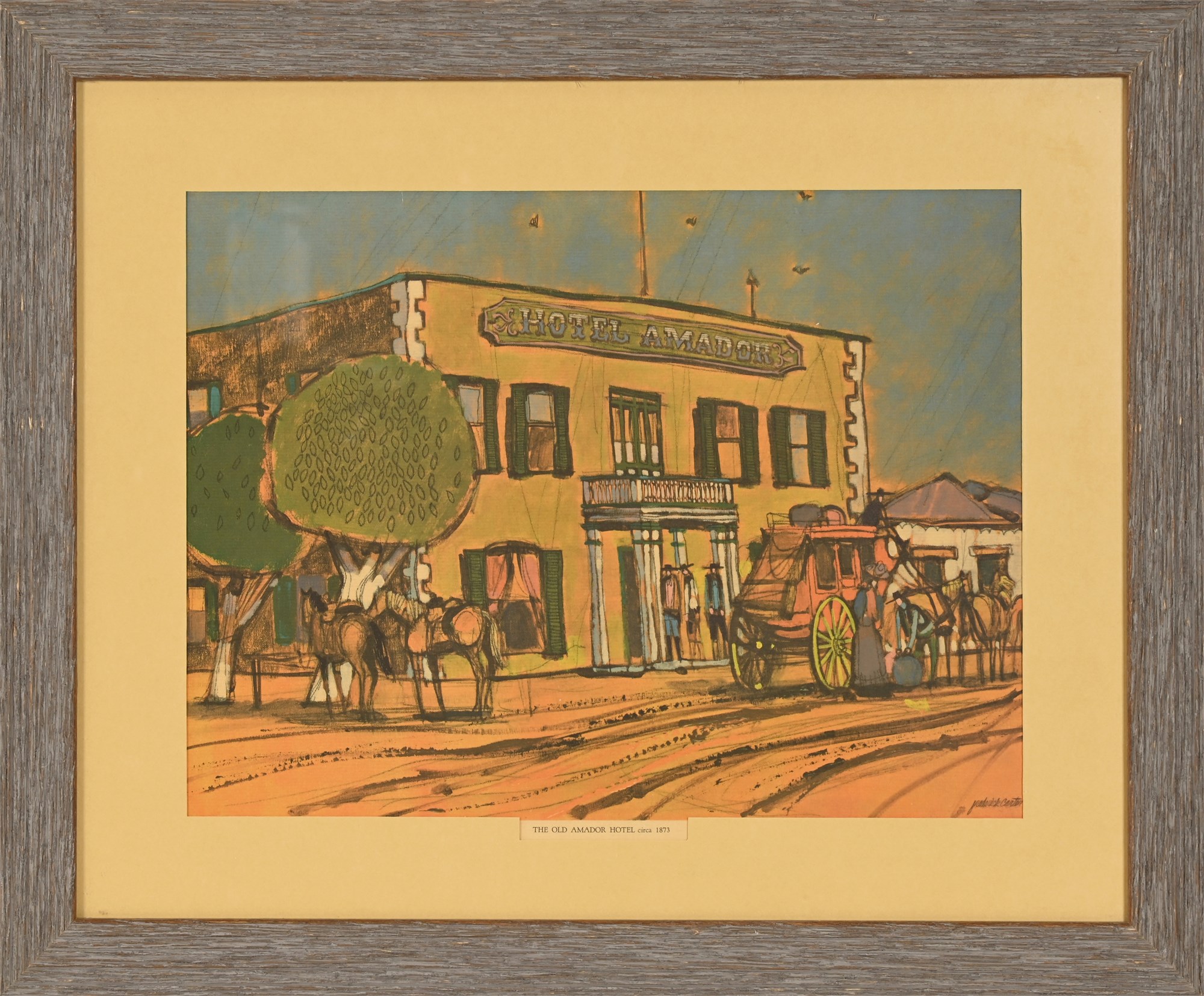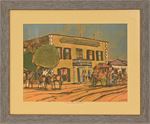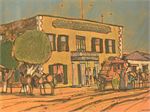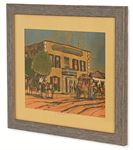'The Old Amador Hotel' by Frederick Carter, Circa 1873 View Watchlist >
- Winning Bid: $211.87
- 47 Bid(s) View Bid History
- High Bidder: nkolsen
Seller Accepts Credit Cards
Payment and pickup instructions will be available on your invoice (under "My Account") at the conclusion of this auction.
Lot # A487
System ID # 20819250
Start Date
End Date
1 Watching
'The Old Amador Hotel' by Frederick Carter, Circa 1873
This beautiful print, titled "The Old Amador Hotel", captures the historic charm of the renowned Las Cruces landmark. Created by artist Frederick Carter, the piece showcases vibrant colors and intricate details, bringing to life a bustling 19th-century scene featuring the iconic hotel, stagecoaches, and lively figures. Presented in a rustic wood frame with a matted border under glass, this artwork is complemented by historical text mounted on the verso, offering a rich narrative about the Amador Hotel’s legacy. This piece is a delightful blend of history and artistry, perfect for collectors or admirers of Southwestern charm.
- Title: 'The Old Amador Hotel' Circa 1873
- Artist: Frederick Carter
- Medium: Print
- Unsigned, Artist Name Visible Lower Right
- Rustic Style Wood Frame Matted with Glass
Condition:
Good condition. The artwork and matting are clean and well-preserved under glass. The rustic wood frame shows light wear consistent with age, enhancing its vintage character.
Size:
Overall: 16.5" X 20"
Visible: 10.25" X 13.75"
From the Rear:
THE AMADOR HOTEL: A REFLECTION OF LAS CRUCES' PAST AND A MIRROR FOR ITS FUTURE
Over a century ago, the Amador opened its doors as a rooming house for bone-weary teamsters and travelers on Don Martin Amador’s freight routes. Since those days in the early 1850s, the building has served a growing Las Cruces as its first post office, court, jail, theater, fortress, and hotel.
Later, the structure became the new Citizens Bank of Las Cruces. Through each transition, the structure retained a fascinating mixture of the old and the new. It collected stories and traditions amassed through the years and preserved them within its walls. It was truly a museum hotel that was unique in all of America.
The hotel lobby was an enchanting record of four centuries, and it would take an art catalog to describe all the relics that were contained there. Such diverse items as a Bengal tiger skin from India shared the spotlight with a hand-carved Buddhist shrine from China. A life-sized figure of Mexican matador Miguel Lopez still stands in the bank today. The statue is dressed in the cape and suit the matador wore when killed in an Oaxaca, Mexico, bullring. Blood stains, where Lopez was gored, are said to still be visible on the inside lining of the cape.
During the Civil War, the Amador was the main social center for Las Cruces and the surrounding area. Dashing cavalry officers from nearby Fort Seldon and Fort Fillmore would crowd the lobby Saturday nights to attend the stately dances held there.
In 1885, Don Martin constructed a stage at the north end of the lobby where the stairs are now to accommodate theatrical performances. For decades, the Amador was the only entertainment center between El Paso and the rowdy gold towns farther west.
Much of Don Martin’s life was spent as a probate magistrate, and he was often the only law for a large area. The hotel, for a time, served as both a court and jail and once held Billy the Kid.
Years passed, and the hotel eventually lost most of its various identities. The stage was removed, and the hotel underwent redecorating and enlarging. During the 1930s, Corina, Don Martin's daughter, removed the room numbers and named each room after a member of the family or a family friend. All of the second-floor rooms in the new bank still retain the names instead of numbers.
The reputation of the historic hotel spread after World War II, and guests from all over the United States, Europe, and the Far East visited the “museum” hotel. Many were known to register for a night and end up staying for years. During the 1950s and early 1960s, the Amador became a haven for artists and writers, and much of their work, done in the hotel’s lobby, remains behind today.
The directors and officers of the new Citizens Bank of Las Cruces, aware of the rich heritage of the building they now occupy, have set aside two rooms, to the right and left of the bank's entrance, as a museum where many of the valuable old relics of the Amador are stored.
While other landmarks of the past continue to fall to progress, the Amador, with each new identity it assumes, serves as a sign of that progress.
Presented to patrons and friends of the Citizen's Bank of Las Cruces to commemorate the bank's opening, April 5, 1970.





